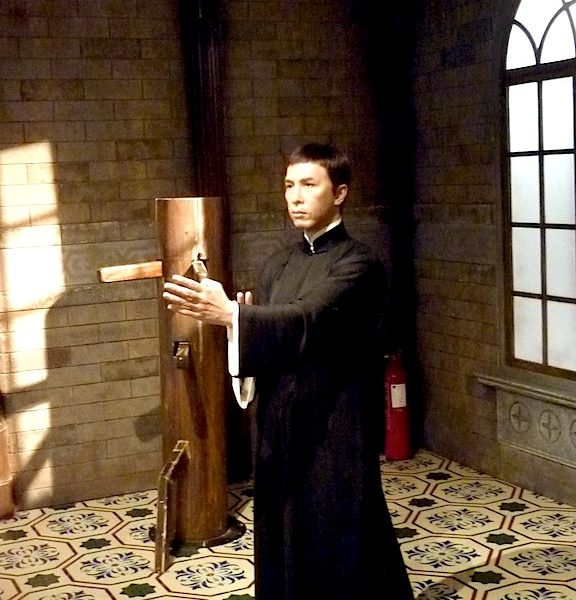Are the Ip Man Fight Scenes Legit Wingchun?

The Ip Man film series is based on the life of the most popular Wing Chun master, Ip Man (aka Yip Man), portrayed by martial arts superstar Donnie Yen. There are also a few offshoots as well. From time-to-time people ask us, when they see “wing chun” or Ip Man movies, how come some of the things that we do are not exactly like in the films? People even try to emulate the movements portrayed in the movies, but they may deviate from the actual martial art.
Most people realize that even though a movie may be based on real-life events (Ip Man was a real person), probably 50% or less of the content is accurate. The “wing chun” movies are no different. So, for clarification, I wanted to pick out a few examples from the Ip Man movies and explain some differences and similarities between the movies and real WingChun.
In the first Ip Man movie, there is a scene in which Ip Man was surrounded by about 20 or so karate black belts, and he proceeded to fight them with chain punches and different techniques all at once. That is not actually a strategy that we use in WingChun. We prefer to use our footwork to line people up in order to fight them one at a time, or even better, try to escape the situation altogether because that type of situation against multiple people is not one that you can easily win.
In the next movie, there was a scene in which Ip Man fought on top of a table against another kung fu master played by legendary Chinese action star Samo Hung. That is actually training that some people do when sparring or while training chi sao which emphasizes footwork, close-quarters movements, and balance in order to keep from falling off of the table.
In the last part of Ip Man 2, he fought a British boxer and was getting beaten badly. Ip Man was able to turn the fight around by attacking the boxer’s bicep when the boxer punched from the outside. This is actually a legitimate WingChun tactic. We call this “attack the attack” and instead of blocking, we intercept and cause damage to the attacker’s limb, which is a pretty effective tactic.
In the third movie, we will cover two examples as well. In one scene, Ip Man fought a Thai fighter and used the stance from Siu Nim Tau to prevent himself from falling down steps. Although one of the functions of a stance is to maintain balance, using it in this way is a bit of a stretch.
In a later fight scene, Ip Man fought a boxer who was played by former world heavyweight champion Mike Tyson. Ip Man defended punches by blocking with his elbows. Some people ask me if that is a real technique. Well, that is actually a legitimate WingChun tactic. If someone lands a punch on your elbow, it can actually break their hand which is also very effective.
In the same fight, Ip Man crouched into what looks like a pistol squat in order to take advantage of a lower position. I’ve never seen that before and do not think it is legitimate technique.
There are also other Ip Man movies outside of the Donnie Yen series. One in particular depicts Ip Man when he was younger and happened to fight ninjas. I don’t think that actually transpired. A lot of the events in these movies I’ve never heard of, and I’ve been training years before the movies were made.
The last movie that I’d like to point out is The Grandmaster. There is one particular line that a person asked me about when Ip Man said that he only needed three moves which were tan, bong, and fok. This person, who saw the movie, asked if there are actually only three movements in WingChun. The answer is no, we have more than three techniques, many blocks, and even more than one type of punch. I would say that tan, bong, and fok are just the fundamental movements in the WingChun chi sao training exercise, but the character was confident that he only needed those three.
Hopefully that clears up some misunderstandings that you may have. Ip Man 4 will be in theaters soon. Overall, the Ip Man movies capture the general essence of WingChun (considering the several interpretations) along with the standard movie exaggerations made to the martial arts techniques and actual events.